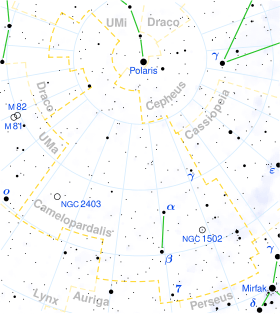BK Camelopardalis
BK Camelopardalis is a solitary[9] variable star in the northern circumpolar constellation of Camelopardalis, near the constellation border with Cassiopeia. It is visible to the naked eye as a faint, blue-white hued star with an apparent visual magnitude that fluctuates around 4.74.[2] The star is located approximately 540 light years away from the Sun based on parallax.[1] It is a proposed member of the Cassiopeia–Taurus group of co-moving stars.[10]
 | |
| Observation data Epoch J2000 Equinox J2000 | |
|---|---|
| Constellation | Camelopardalis |
| Right ascension | 03h 19m 59.27222s[1] |
| Declination | +65° 39′ 08.2519″[1] |
| Apparent magnitude (V) | 4.74[2] (4.76 - 4.90)[3] |
| Characteristics | |
| Evolutionary stage | main sequence[4] |
| Spectral type | B2.5 Vne[5] |
| U−B color index | −0.77[6] |
| B−V color index | −0.108±0.002[2] |
| R−I color index | −0.13[6] |
| Variable type | Be star[3] |
| Astrometry | |
| Radial velocity (Rv) | −3.4±3.5[2] km/s |
| Proper motion (μ) | RA: +10.506[1] mas/yr Dec.: −14.677[1] mas/yr |
| Parallax (π) | 6.0704 ± 0.3539[1] mas |
| Distance | 540 ± 30 ly (165 ± 10 pc) |
| Absolute magnitude (MV) | −2.07[2] |
| Details | |
| Mass | 7.5[5] M☉ |
| Radius | 4.0[7] R☉ |
| Luminosity | 1080.69[2] L☉ |
| Surface gravity (log g) | 4.20[4] cgs |
| Temperature | 18,720[4] K |
| Rotational velocity (v sin i) | 328[4] km/s |
| Age | 31.6[5] Myr |
| Other designations | |
| Database references | |
| SIMBAD | data |
This is a main sequence Be star[4] with a stellar classification of B2.5 Vne,[5] where the 'n' suffix indicates "nebulous" (broad) lines due to rapid rotation. The presence of emission lines in the spectrum has been known since at least 1895.[11] Spectrograms of the star have been taken since 1905, providing a long history of its cycles of variation.[12] It ranges in brightness from a peak of 4.76 down to 4.90.[3]
BK Camelopardalis is 32[5] million years old and is spinning with a projected rotational velocity of 328 km/s.[4] It has 7.5[5] times the mass of the Sun and four[7] times the Sun's radius. The star is radiating 1,081[2] times the luminosity of the Sun from its photosphere at an effective temperature of 18,720 K.[4]
This star lies at the center of a circular, disk-like structure spanning 1.4°, which may be a "magnetic funnel-like structure" that is emitting in the radio band. Neutral hydrogen along the trajectory of this star has been found to be deficient, which may be the result of ionizing radiation from the star.[13]
Chinese name
In Chinese, 紫微右垣 (Zǐ Wēi Yòu Yuán), meaning Right Wall of Purple Forbidden Enclosure, refers to an asterism consisting of BK Camelopardalis, α Draconis, κ Draconis, λ Draconis, 24 Ursae Majoris, 43 Camelopardalis and α Camelopardalis.[14] Consequently, BK Camelopardalis itself is known as 紫微右垣七 (Zǐ Wēi Yòu Yuán qī, English: the Seventh Star of Right Wall of Purple Forbidden Enclosure.) representing 上丞 (Shǎngchéng), meaning First Prime Minister.[15]
References
- Brown, A. G. A.; et al. (Gaia collaboration) (August 2018). "Gaia Data Release 2: Summary of the contents and survey properties". Astronomy & Astrophysics. 616. A1. arXiv:1804.09365. Bibcode:2018A&A...616A...1G. doi:10.1051/0004-6361/201833051. Gaia DR2 record for this source at VizieR.
- Anderson, E.; Francis, Ch. (2012). "XHIP: An extended hipparcos compilation". Astronomy Letters. 38 (5): 331. arXiv:1108.4971. Bibcode:2012AstL...38..331A. doi:10.1134/S1063773712050015.
- Samus, N. N.; et al. (2017). "General Catalogue of Variable Stars". Astronomy Reports. 5.1. 61 (1): 80–88. Bibcode:2017ARep...61...80S.
- Zorec, J.; et al. (2005). "On the evolutionary status of Be stars. I. Field Be stars near the Sun". Astronomy and Astrophysics. 441: 235. arXiv:astro-ph/0509119. Bibcode:2005A&A...441..235Z. doi:10.1051/0004-6361:20053051.
- Tetzlaff, N.; et al. (2011). "A catalogue of young runaway Hipparcos stars within 3 kpc from the Sun". Monthly Notices of the Royal Astronomical Society. 410: 190. arXiv:1007.4883. Bibcode:2011MNRAS.410..190T. doi:10.1111/j.1365-2966.2010.17434.x.
- Ducati, J. R. (2002). "Catalogue of Stellar Photometry in Johnson's 11-color system". CDS/ADC Collection of Electronic Catalogues. 2237. Bibcode:2002yCat.2237....0D.
- Underhill, A. B.; et al. (1979). "Effective temperatures, angular diameters, distances and linear radii for 160 O and B stars". Monthly Notices of the Royal Astronomical Society. 189 (3): 601. Bibcode:1979MNRAS.189..601U. doi:10.1093/mnras/189.3.601.
- "BK Cam". SIMBAD. Centre de données astronomiques de Strasbourg. Retrieved 2019-08-12.
- Eggleton, P. P.; Tokovinin, A. A. (September 2008). "A catalogue of multiplicity among bright stellar systems". Monthly Notices of the Royal Astronomical Society. 389 (2): 869–879. arXiv:0806.2878. Bibcode:2008MNRAS.389..869E. doi:10.1111/j.1365-2966.2008.13596.x.
- de Zeeuw, P. T.; et al. (January 1999), "A HIPPARCOS Census of the Nearby OB Associations", The Astronomical Journal, 117 (1): 354–399, arXiv:astro-ph/9809227, Bibcode:1999AJ....117..354D, doi:10.1086/300682
- Campbell, W. W. (October 1895). "Stars whose spectra contain both bright and dark hydrogen lines". Astrophysical Journal. 2: 177−183. Bibcode:1895ApJ.....2..177C. doi:10.1086/140127.
- McLaughlin, Dean B. (May 1963). "The be Spectrum Variable HD 20336". Astrophysical Journal. 137: 1085. Bibcode:1963ApJ...137.1085M. doi:10.1086/147587.
- Haverkorn, M.; et al. (June 2003). "Multi-frequency polarimetry of the Galactic radio background around 350 MHz. II. A region in Horologium around l = 137degr , b = 7degr". Astronomy and Astrophysics. 404: 233−247. Bibcode:2003A&A...404..233H. doi:10.1051/0004-6361:20030530.
- (in Chinese) 中國星座神話, written by 陳久金. Published by 台灣書房出版有限公司, 2005, ISBN 978-986-7332-25-7.
- English-Chinese Glossary of Chinese Star Regions, Asterisms and Star Name Archived August 10, 2010, at the Wayback Machine, Hong Kong Space Museum. Accessed on line November 23, 2010.